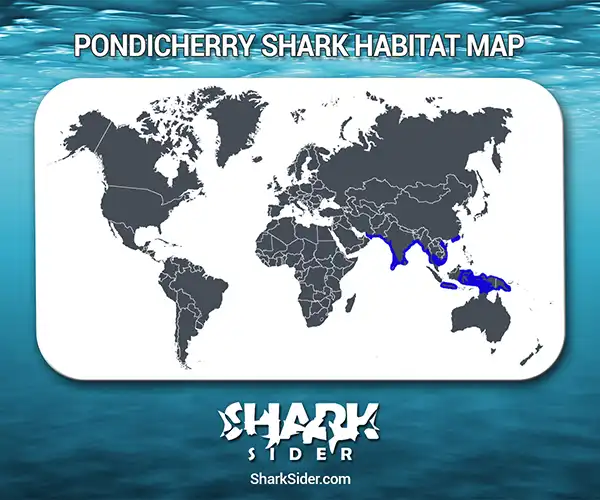The Pondicherry shark is an endangered species of migratory requiem sharks belonging to the Carcharhinus genus.
Also commonly known as the long-nosed shark, it was discovered in 1839 by German biologists Johannes Müller and Jakob Henle. They published the first scientific description of the Pondicherry shark based on an immature male shark of just 19 inches, captured from Pondicherry in India.
The Global Wildlife Conservation’s “Search for Lost Species” initiative put this shark on the list of 25 most wanted lost shark species. Although it is difficult to spot it in its natural habitat, it keeps appearing in fishing markets throughout the coastal areas of the Indian subcontinent.
It has barely survived extinction since its population decline. With less than 20 specimens available for research and study(most collected before the 1900s), most aspects of its natural history and body anatomy are unknown.
Pondicherry Shark Scientific Classification |
|
| Kingdom | Animalia |
| Phylum | Chordata |
| Class | Chondrichthyes |
| Order | Carcharhiniformes |
| Family | Carcharhinidae |
| Genus | Carcharhinus |
| Scientific Name | Carcharhinus hemiodon |
Description
The Pondicherry sharks are not known to grow more than 3.3 ft. The smallest recorded specimen is a a female, measuring 13 inches.
The top of their body is gray and whitish on the under-belly. The tips of their pectoral fins and upper and lower caudal-fin lobes are black. They have pale stripes on their flanks.
It has a modestly sized snout that is pointed and consists of a pair of nostrils with a small, narrow nipple-shaped lobe on the anterior rim. Its large circular-shaped eyes consist of nictitating membranes.
The upper and lower jaws contain 14-15 and 12-14 rows of teeth on each side, respectively.
Moreover, their top rows of teeth are saw-like at the base and smooth-edged near the tip. In contrast, the smoother or finely serrated lower teeth are narrower and more upright. Two smaller rows of teeth are visible on the midpoints of either jaw.
There is the presence of small tooth-like scales that overlap called dermal denticles, consisting of three horizontal ridges leading to three or five marginal teeth.
Where do they live
Map Of The Pondicherry Shark’s Habitat

The Pondicherry shark was once extensively found in the Indo-Pacific region, from India to New Guinea. Most known specimens have been collected from India, the Gulf of Oman, Borneo, and Java.
This species inhabits coastal waters. Pondicherry sharks thrive in river and sea basins as they feed close to the ground.
Behavior
Social
Sharks are a social species, interacting with other species to help them communicate. Since they are incapable of verbal communication, they implement specific body language and actions such as moving and shaking their head, opening and closing the jaw and arching.
Hunting
The Pondicherry sharks are great hunters. While chasing prey, they deploy a slapping gesture that acts as a warning mechanism to other sharks or predators that may come in their way. The shark’s sharp teeth help them subdue and devour their prey.
Dietary
The Pondicherry shark preys upon small bony fishes, cephalopods, and crustaceans.
Reproductive
Pondicherry sharks are viviparous organisms and take a long time to mature sexually. They hit the maturity phase at a length of over 24 inches.
The mating period involves- the males swimming side-by-side with the females and engaging in intercourse. The males often injure the females with bite marks when holding them firmly. The females give birth to pups after being in an incubation period for about nine months or sometimes even two years.
The developing embryos inside the mother get nourishment and undergo gaseous exchange via a placental connection to the mother.
Adaptations
Old reports have shown that the Pondicherry shark even dwelt in rivers and fisheries. If true, these sources might help point out how these sharks have low salinity tolerance levels, which makes them access freshwater sources. There have been reports of these sharks entering inshore water sources like the Hooghly and Saigon rivers.
Interactions with humans
A Critically Endangered species as categorized by the IUCN, the Pondicherry shark was once available throughout the coastal Indian subcontinent. Because of their harmless nature, they were caught in numbers and hunted for their meat.
Their population reduced rapidly, so much so that only a handful of specimens collected in the last century were available in museums for research. Due to their rare sightings, the Pondicherry shark was feared to have gone extinct.
In 2016, it was rediscovered in the Sri Lankan rivers of Menik and Kumbukkam, putting all extinction fears at rest.
